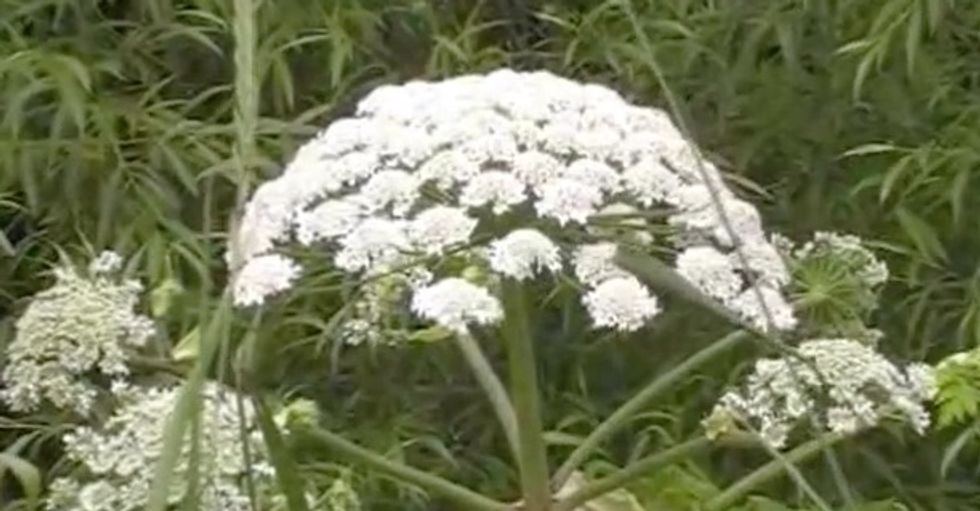
Image source: YouTube

It's called the giant hogweed and it can grow to heights of 14 feet or more. The white flowers appear innocent enough. However, a nasty secret is hiding in the sap of the plant.
What you need to know about toxic giant hogweed plants https://t.co/HMM1KfBCuG pic.twitter.com/oaH3wOwXRz
— The Independent (@Independent) July 14, 2015
Lurking inside the stalks and stems of the plant is a toxic sap to be avoided at all costs. Merely coming in contact with the sap can cause severe blistering on human skin and in some cases, third-degree burns.

The hands seen in the photo belong to Lauren Fuller, a 10-year-old girl who was on a fishing trip with her father. The young lady came in contact with the the sap of the giant hogweed when she brought a stalk home. Less than a day later, the skin on both of her hands was burning with pain. A visit to the hospital produced a misdiagnosis of "sunburn."
In recent weeks, New York State's Department of Environmental Conservation and the state of Massachusetts have issued detailed public warnings about the plant and the serious problems caused by coming in contact with it. These two states are not alone. In the northeastern region, Vermont, New Hampshire and Maine are all reporting sightings of the plant. Maryland, Virginia, Ohio, Pennsylvania and Michigan are sending out warnings. Out west, Oregon and Washington have seen giant hogweed spreading.
How do you identify the giant hogweed? The size of the plant is one key way to differentiate it from similar looking weeds. However, before it grows taller than a typical human, it can look like cow parsnip and its cousin, wild parsnip.
Learn the difference between giant hogweed, cow parsnip and wild parsnip. Visit https://t.co/HknFAM7BQY to learn more pic.twitter.com/wexHLwYWEq
— Invading Species (@invspecies) July 13, 2015The flowers of the giant hogweed look more like an umbrella. The parsnip plants flower in a much flatter manner. Horticultural social media accounts are sharing useful tips and photo comparisons to help people learn how to identify good plants from the bad plants.
Do YOU know how to identify Giant Hogweed? Report ALL sightings in the Sea to Sky. #eradicate https://t.co/joPXiSNK6G pic.twitter.com/NXAjmokfqX
— Sea To Sky Invasives (@SSinvasives) July 9, 2015Where can you find the giant hogweed? It thrives in soggy soil found along riverbanks.
Mass of Ranunculus on the Aire but watch out for giant hogweed https://t.co/G7wNs5yaud @aireriverstrust @YorksWildlife pic.twitter.com/oSV9jFvn1v
— Jonathan Grey (@ProfJGrey) July 1, 2015What do you do if you come in contact with the sap from a giant hogweed? The first thing experts advise: thoroughly wash the skin that came in contact with the sap. The sun's UV rays are also believed to trigger the chemicals in the sap. Doctors advise those affected to stay out of the sun.
How serious is the invasion of these nasty weeds? With a dozen states issuing alerts and reports of kids, adults and even pets suffering from the burns, it appears to be worth noting.
Watch the latest report from a Boston area television station that found the giant hogweed growing nearby:
Boston News, Weather, Sports | FOX 25 | MyFoxBoston
__
Follow Mike Opelka (@Stuntbrain) on Twitter.